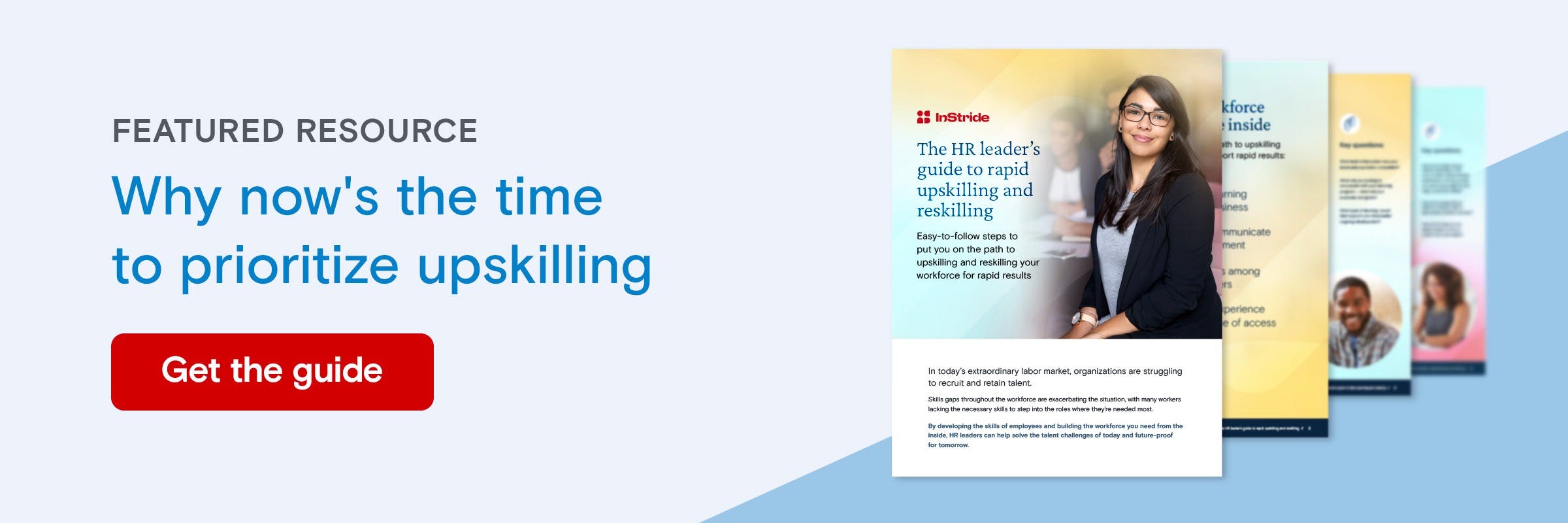If you work in the learning and development (L&D) space, you’ve likely heard the term “learning ecosystem” come up in strategy discussions. And although it may seem like just another trending topic, it introduces an important idea that — when executed correctly — can help L&D leaders cultivate a self-sustaining culture of growth and learning within an organization.
In its simplest form, a learning and development ecosystem exists to move your organization and its employees forward through continuous learning, education and development. For most leading companies, cultivating this type of environment is a top priority because it leads to heightened business outcomes.
One study reports that 87% of Millennials seek out development opportunities in potential employers, indicating growth and advancement as a priority for the most represented generation in the workforce today.
This is critical, as a continuously improving workforce has the potential to accelerate business growth and give organizations a 30% greater chance at being a market leader. A learning-oriented work environment also helps employees feel more capable and well-rounded in their professional roles, thus reducing turnover and improving employee engagement.
Although you likely already have some foundational elements of a learning ecosystem in place, let’s take a closer look at what actions you can take to elevate these efforts and drive real L&D results.
What is a corporate learning ecosystem?
A corporate learning ecosystem is a self-sustaining system of people, technology, resources, content and culture that fuel the learning environment within a company. These are elements put in place that allow employees to learn and develop their skills at work.
Each component of a learning ecosystem is interconnected and interdependent. This means that if one piece is removed or changed, it impacts the entire system. For example, your learning ecosystem could be functioning seamlessly. However, if a certain resource, such as budget or a particular learning course, is removed, it could impede employee participation in your L&D programs – damaging the learning culture and the greater ecosystem as a whole.
To have a learning ecosystem that’s set up for long-term success, it’s important to understand all of the necessary elements that allow it to function and prosper.
Learning culture vs. learning ecosystem
Although these terms sound similar and are both interrelated L&D concepts, they are not the same thing.
A learning culture refers to a work environment that prioritizes skills development and knowledge sharing as central to its values. Employees participating in a learning culture readily take in new information and are enthusiastic about sharing what they’ve learned with others in the organization.
A learning ecosystem includes and is reinforced by a learning culture, but defines a broader system in which a learning culture exists. It’s an all-encompassing term that includes the culture and the people, resources and tools that make a learning and development strategy possible.
Components of a corporate learning ecosystem
A core characteristic of a learning ecosystem is that its components are interactive and interdependent. To better understand how they work together, let’s break down what each of these components individually:
- People
Employees play a critical role in cultivating a learning and development ecosystem. Everyone from the executive team to the most junior-level employee is responsible for contributing to and participating in the workplace culture that feeds into a greater learning ecosystem. If your people don’t have a growth mindset, it poses a challenge to your L&D strategy. - Content
Content in a learning ecosystem comes in many different formats. This includes formal educational materials such as a university lecture series or training video course. It may also include informal information, such as the advice and/or mentorship of other employees or internal company resources. - Technology
Almost every aspect of a learning ecosystem is impacted by technology. Tech influences what’s being taught, how it’s being taught and what devices or platforms it’s being taught on. This allows employees to access a variety of online learning methodologies and to engage with educational content in ways that work best for them and their unique learning needs. - Learning culture
A workplace learning culture drives engagement across your ecosystem. For an ecosystem to be successful, the idea of continuous learning and growth has to be central to your company culture and values. A thriving learning culture is marked by employees that want to continue developing their skills, seek advancement and support their colleagues in doing the same. - Data
As with any L&D strategy, it’s important to analyze and adjust your learning ecosystem as needed. Engage metrics to track employee behavior and continuously evaluate whether or not your efforts are driving impact both at the employee and organizational level.
How to build a thriving corporate learning ecosystem
It’s likely that your organization already has one or multiple components in place that form the beginnings of an enterprise-wide learning ecosystem. Here are some additional considerations to help elevate those efforts:
- Evaluate all components equally
Every component of your learning ecosystem is vital to its overall success. For example, without the right technology, it can be difficult to deliver educational content to your employees in an easily accessible format. But if the content you’re offering doesn’t resonate with team members in the first place, it doesn’t matter what technology is used — the learning program is at risk of being underutilized.
For L&D leaders, it’s important to evaluate every component equally, understand how they’re connected and strategize how to move each piece forward in a way that’s beneficial to the greater ecosystem. - Assign tangible roles within your ecosystem
As mentioned earlier, your learning ecosystem needs support from its people component in order to thrive. Everyone — from the CEO to the newest employee — should understand how they fit into that strategy. It may be your responsibility to implement the strategy, but employees at all levels play a part in enabling it to thrive. Executives drive learning as a value within company culture, people managers support their direct reports on their learning journey and all employees want to learn and advance their careers. - Align your learning ecosystem to support business goals
Workforce data shows that continuous employee development and learning is good for business. But this can only happen if your learning initiatives are aligned with greater company goals. Whether you’re evaluating a new learning management system or considering a workforce education program, measurable business outcomes should be central to your strategy.
The most important thing to take away from this is that adaptation is the key to a successful ecosystem. As technology, company culture and the needs of your business grow and evolve, so should your L&D strategy. What’s worked historically isn’t always going to be the right approach today and in the future. Track the data, collect employee feedback about the effectiveness of yourworkplace learningprograms and be prepared to make adjustments along the way.
Evaluating and uplifting each element within your corporate learning ecosystem is the first step you need to take toward strategizing a robust, sustainable and long-lasting L&D initiative.
Ready to grow your corporate learning ecosystem? Learn why employees want more than tuition assistance and how to implement a modern workforce education program that equips your people with the skills they need to advance.


